Self-contained systems of unusual interest
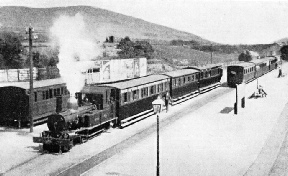
A NARROW-GAUGE TRAIN on the Isle of Man Railway. The photograph shows Ramsey trains crossing at St. John’s Station. The coach in the background is that used for the St. John’s-Foxdale service. The Island is served by two companies, the Isle of Man Railway and the Manx Electric Railway. The former and older system was formed in 1872.
THE title “Island Railways” may mean a number of things. British main lines are island railways; so are those of New Zealand, Java, Japan, and Ireland. But those systems are all relatively large, and worked with rolling-stock and equipment of the most advanced order. Thus they are in the same category as the great lines operating on the continents of the world. The smaller islands will receive attention on this page, and particularly those islands which have a more limited railway system than usual, and present uncommon aspects of railway working.
It must not be assumed, however, because a railway is small, and serves a small island, that it will be antiquated and decrepit. A little railway may be completely suited to the limited, sea-girt locality which it serves. This chapter will explain how this comes about.
The Isle of Man is served by a comprehensive and interesting railway system, worked by two companies, the Isle of Man Railway and the Manx Electric Railway. The Isle of Man Railway is the older and the more extensive. The company was formed in 1872, and the first section, eleven and a half miles long, from Douglas via St. John’s to Peel, was opened for traffic on July 2 of the following year. The 3 ft gauge was adopted because of the mountainous character of the island, and all railway construction involved sharp curves.
August 1874 saw the opening of the line from Douglas to Castletown and Port Erin, serving the southern portion of the island. The original scheme of the Isle of Man Railway included an extension from St. John’s north-east to Ramsey; but lack of support caused its abandonment.
The people of Ramsey then formed the Manx Northern Railway. A line was built from Ramsey to St. John’s, on the Isle of Man Railway, and through but circuitous railway communication was established between Ramsey and Douglas.
A short branch - two and three-quarter miles long - runs south from St. John’s to Foxdale. The line was built to reach the Foxdale silver-lead mines, now closed. It was formerly worked by the Manx Northern Railway. For practically its entire length it has a continuous gradient of 1 in 49, much of the route being cut out of the side of the South Barrule Mountain.
In 1904 the Manx Government authorized the absorption of the Manx Northern Railway by the Isle of Man Railway.

AT THE SUMMIT TERMINUS of the Snaefell Mountain Railway in the Isle of Man. A part of the “Fell” apparatus employed to overcome the severe gradients can be seen attached to the front of the bogie. The mountain line comprises nearly five miles of 3 ft 6-in gauge double track. Electric power is obtained from overhead wires.
The three original locomotives of the Isle of Man Railway were of the 2-4-0 type, and were named “Sutherland”, “Loch”, and “Pender”. They are still in existence, and their design remained an unchanged standard until 1926, when the “Mannin” was built, a similar though bigger engine. There are fifteen of them altogether; they are handsome little machines, painted green, with ornamental highly-polished brass dome covers. Some have been rebuilt with larger boilers. There is one exception to the class, which came from the Manx Northern Railway. This is an 0-6-0 of rather plain appearance. Called “Caledonia”.
The Isle of Man Railway to-day operates forty-six and a quarter miles of route. This is made up of the original main line, crossing the island from Douglas to Peel, the line from Douglas, along the southeast coast to Castletown and thence to Port Erin (fifteen and a half miles), and the two branches from St. John’s, on the Peel line. One of these is the short branch to Foxdale, referred to above; the other, sixteen and a half miles long, passes through Kirk Michael and Ballaugh to the important northern town of Ramsey. This branch was formerly the main line of the Manx Northern Railway. The railway serves mountain scenery of the most beautiful and romantic character. Glen Mona, Glen Wyllin, and Sulby Glen all occurring on the northern section to Ramsey. Most of the place names are, of course, Manx Gaelic, though Sulby is possibly a relic of the conquest of the island by Vikings from Scandinavia in the ninth century. So, too, is Foxdale, in all likelihood.
The Isle of Man Railway has always been a thoroughly successful concern. There are two reasons for this. In the past, it has not suffered from competition on the part of other railways. To-day, thousands of tourists visit the island every season, and, for obvious reasons, few bring their own motor cars. Therefore, with its low fares and excellent train service, the company reaps a good harvest. Furthermore, it effectively dealt with road competition in 1920 by absorbing road transport companies and forming the Isle of Man Road Services.
The carriages, as might be expected on the 3 ft gauge, are not roomy, but they have many good points. They are of the ordinary compartment type, built low on the ground, rendering high platforms unnecessary. They are all electrically lighted, and with the exception of some coaches from the Manx Northern Railway, are mounted on bogies. But they are not steam-heated; tin foot-warmers keep out the cold in winter. This is not so inconvenient as it sounds, for there are no long journeys in the island, and the foot-warmers have no time to lose all their heat.
The whole system has a neat and well-kept appearance, the station buildings at Douglas, the headquarters of the company, being remarkably good. There are a wide circulating area and four long platform faces, protected by glass roofing. All signals and points at Douglas are interlocked, though this is not compulsory in the island. The trains are fitted with automatic vacuum brakes. The railway has an excellent safety record.
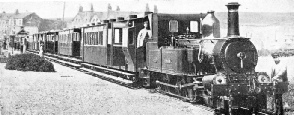
ON THE ISLE OF MAN RAILWAY. A passenger train about to leave Port Erin Station. The line from Douglas to Castletown and Port Erin, which serves the southern portion of the island, was opened in August, 1874.
All the Manx locomotives, except “Caledonia”, were built by Beyer, Peacock & Company Ltd, at Manchester. “Caledonia” was built in Glasgow by Dubs & Company (now incorporated with the North British Locomotive Company) in 1885. All engines carry their numbers on the chimneys, and their names on brass plates fixed to the tank sides.
The speeds are not high, for high speed must not be expected on a narrow-gauge railway serving extremely hilly country; a maximum of thirty-five miles an hour is usual. The fine little locomotives could doubtless do considerably more than that, but it is improbable that they will ever be allowed to do so. The journey from Douglas to Peel takes thirty-eight minutes, with stops at all stations; and to Ramsey, over the old Manx Northern line, one hour and nineteen minutes.
There is also, however, a limited stop train in service. This is a train which runs from Douglas to Ramsey in one hour.
The Manx Electric Railway from Douglas to Ramsey is built to the 3-ft gauge, the same as that of its steam-operated neighbour, but it has no locomotives. The line is worked throughout by motor and trailer electric cars, together with mail vans and goods wagons. The company also owns road motor coaches and lorries, but it lives quite harmoniously with the older Isle of Man Railway. The Manx Electric Company was formed in 1902. In addition to its main line, which carries the Royal Mail to Rarnsey, the Manx Electric has a remarkable branch line running westwards from Laxey to the mountain Snaefell, the summit of which is 2,034 ft above sea-level. This Snaefell Mountain Line is built to the 3 ft 6 in gauge, and works on the Fell system, with horizontal braking wheels gripping the two sides of a central rail. Snaefell is a Norse name, meaning “Snow Mountain”, but it is snow-covered only at certain times of the year.
In the Isle of Wight
The Manx Electric rolling-stock combines railway and tramway practice, and includes open-sided cars with the “toast-rack” arrangement of seating. These cars give the traveller a fine view of the beautiful country through which the railway passes, and they are pleasant in hot summer weather. Current is collected from an overhead trolley wire, on both the main line and the Snaefell line.
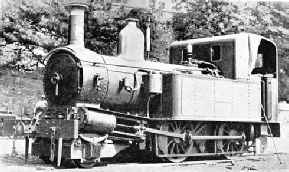 A STANDARD 2-4-0 TANK locomotive which was built for the Isle of Man Railway by Messrs. Beyer, Peacock & Co Ltd, of Manchester. The three original 2-4-0 locomotives built for this narrow-gauge line are still to be seen in operation.
A STANDARD 2-4-0 TANK locomotive which was built for the Isle of Man Railway by Messrs. Beyer, Peacock & Co Ltd, of Manchester. The three original 2-4-0 locomotives built for this narrow-gauge line are still to be seen in operation.
Another Manx electric line is the Douglas Southern Electric Railway, which runs south-west from Douglas to Port Soderick, a distance of three and a quarter miles.
A line rather similar to the Manx Electric Railway runs between Rothesay and Ettrick Bay, on the Isle of Bute. This is Scotland’s only island railway, though, after the war of 1914-18, railways were proposed in the Isle of Lewis, in Skye, and in Arran. These came to nothing, as the then rapidly developing road motor-bus and lorry were found more suited to those localities.
The railway system of the Isle of Wight is now a part of the Southern Railway, being operated with its standard branch line locomotives and rolling-stock. The locomotives consist of 0-4-4 tank engines from the old London and South Western Railway, and 0-6-0 tanks from the former Brighton line. In the old days, however, there were no fewer than three railways in the island.
The largest was the Isle of Wight Central Railway which had its headquarters at Newport and worked from that town to Ryde, Cowes, and Ventnor. It had a miscellaneous collection of second-hand engines and carriages, the latter including a twelve-wheeler which had once worked on the Midland Scottish expresses. The other carriages and all the engines were small and antique. The Isle of Wight Railway, from Ryde to Ventnor and Bembridge, was a much more uniform system. It had its own standard 2-4-0 tank engines, painted red, and much better carriages than the Central, some having come from the London Metropolitan Railway when the underground lines were electrified.
Finally, there was the Freshwater, Yarmouth and Newport Railway. This was at first worked by the Isle of Wight Central, but after a time independent working was decided upon. Some non-descript old coaches were purchased, together with an engine, third-hand, from the London and South Western. This locomotive had been bought second-hand by the LSWR from the Brighton Railway. The Isle of Wight system, in its day, was of considerable interest to the railway enthusiast.
In the Channel Islands there has not been such a happy state of affairs as in the Isle of Man. Jersey and Guernsey are, perhaps, too small for the rail to provide a satisfactory means of transport. The Guernsey Railway, which was simply an electric tramway, closed down in 1934, and the Jersey Eastern Railway even earlier, in 1929. The latter was a standard gauge steam line, with four 0-4-2 tank engines and two rail-cars.
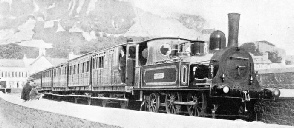
IN THE CHANNEL ISLANDS there is a small 3 ft 6 in gauge line in Jersey which runs between St. Helier and Corbière, a distance of eight miles. This line is operated by the Jersey Railways and Tramways, a company which was a pioneer in the use of the geared steam rail-car. This photograph was taken on another railway, the Jersey Eastern, closed in 1931.
On the other hand, the Jersey Railways and Tramways, on 3 ft 6 in gauge, are still flourishing, and run the island’s road motor services in addition to their eight miles of line between St. Helier and Corbière. This company was a pioneer in the use of the modern geared steam rail-car, the first “Sentinel” cars appearing on the St. Aubin service in the early nineteen-twenties. To-day, the company owns four of these cars, together with four locomotives and no fewer than fifty motor buses.
In the Mediterranean, the little Malta Railway has had the same sad end as the Jersey Eastern, for it was closed down to all traffic on April 1, 1931. A feature of the Malta Railway was the beautiful way in which gardens were bedded out on the platforms. The line pierced the fine old wall of Valletta.
The remaining British island railway in the Mediterranean, the Cyprus Government Railway, has seventy-one miles of 2 ft 6 in gauge line open for traffic, connecting Famagusta with Nicosia and Evrykhou, below lofty Mount Troodos. The system naturally does not boast an intensive train service, such as the Isle of Man Railway can show, but it serves its purpose well, with the help of twelve engines and four rail-cars, seventeen carriages, and 101 wagons.
But the most striking island railway-system in Europe is that of Corsica, which is worked by the Departmental Railways Company of France, and has a route mileage of 184, the gauge being one metre (3 ft 3⅜ in). The Corsican Railways’ system, with its winding mountain lines, is of great interest, both from the engineering and from the aesthetic point of view. The island is one of the most marvellous places in Europe, a vast, rocky group of mountains rising straight out of the tideless sea; a place of great glens and precipices, full of deep blue shadows, and half covered with heavy heathery undergrowth, which, from a distance, resembles a vast growth of thick shaggy moss. Approaching the island from Marseilles, it seems impossible that railways could penetrate its wild interior, yet the French have done this, and they have done it thoroughly.
Travel in Corsica
The main line from Ajaccio - the capital - to Bastia crosses the island from the west to the north-east coast. The journey covers over ninety-eight miles, and, as might be expected considering the island's rugged interior, the gradients are severe, the curves are many, and the speed is anything but high. But slowness is amply compensated by the views from the windows of the train. There are two through services daily in either direction, with a number of extra local trains operating from either terminal.
The “express” is the early afternoon train from Bastia, which takes five and a half hours for the run of just under a hundred miles, stopping at all stations except Borgo, ten and a half miles from Bastia, and Carbuccia, the last station before Ajaccio. But nobody will grudge an afternoon spent on such a magnificent journey. The up “express” from Ajaccio, also an early afternoon train, reaches Bastia at 6.30 pm. These trains are hauled by “Mallet” tank engines of the 0-4-0 + 0-4-0 type, of recent French construction. They are powerful little machines, and glide along the mountain-side tracks with case. The other standard Corsican engines are six-coupled tank locomotives of a much older type, externally distinguished by huge domes surmounted by spring-balance safety-valves. Naturally they are less powerful and less suited to the work than the articulated engines; but there is plenty of life in them yet, and they still do good work.
Some time ago, a vagabond Russian wanted to cross the island quickly. He had no money, but he had resource. He quietly stepped on a little locomotive which was standing in steam in a siding, opened the regulator, and went gaily along the Bastia-Ajaccio main line. It was a mad enterprise. Suited as they are to the winding line, even Corsican engines cannot be allowed to run at excessive speed. This one was found on its side at the first bad curve, while a sadder and wiser Russian, much bruised, was rescued and hurried away to the police station.
The Corsican trains are remarkably good from the passengers’ point of view, considering the remote region which they serve. On the best trains there are some excellent first and second class corridor carriages, which include little “drawing-room” compartments at the ends, resembling miniature Pullman cars. As all the best stock is of the bogie type, the running is smoother than might be expected. From Ponte Leccia, a junction on the main line, between Corte and Casamozza, a branch runs up to the north coast, skirting it from Île Rousse to the beautiful Gulf of Calvi, while another runs southwards along the east coast from Casamozza to Ghisonaccia. Except to worshippers of speed, the Corsican railway system will be found one of the most fascinating in all Europe.
It might be expected that the railways of Sardinia would resemble those of Corsica, but this is far from being so. Sardinian railways are simply the Cagliari Division of the Italian State Railways - Cagliari being the capital - and are worked with their standard rolling-stock, suitable types having been brought over from the mainland. There is a perfectly ordinary Italian mainline atmosphere on the Terranova-Cagliari section, which passes through Monti and Chilivani. The best train is the Italian Boat Express, which includes a restaurant car and covers the 176½ miles in about five and half hours, stopping at six intermediate stations. If this speed seems slow, it must be remembered that Sardinia is not exactly a racing ground. Another Italian possession in the Mediterranean, Sicily, is not only a big island, but is also geographically part of Italy, its railways likewise being worked by the Italian State.
In the Balearic Islands, both Majorca and Minorca have their little railway systems. That of the former has its main line running from Palma to Manacor and Arta, the distances being forty and fifty-eight miles respectively. The fastest run is from Palma to Son Bordils, which is made in seventy-three minutes, without a stop, over the distance of twenty-one and a quarter miles. The Minorcan line is a simple single track connecting Cindadela with Mahon.
In the West Indies are many interesting island railway systems, all differing from one another, though several are British-owned. The Jamaica Government Railways have 210 miles of route, built to the standard 4 ft 8½ in gauge, and with the main line running from Kingston, the capital, westwards to Montego.
Big Locomotives in Jamaica
A branch line also bears round from Spanish Town to the north coast, skirting the Blue Mountains and ending at Port Antonio. Jamaican locomotives might be expected to be on the small side, but this is not so. Typical Jamaican engines of the 4-8-0 class, introduced shortly after the war of 1914-18, and built by the Canadian Locomotive Company, weigh 108 tons 10 cwt with tender, in working order, the overall length being nearly sixty feet, and the height over fourteen feet. In appearance they are a peculiar mixture of American and British practice; the bar frames and high running plates being curiously at variance with a neat outline, characteristic of British railway practice. They carry bells, cowcatchers and electric headlights, as do American locomotives.
The scenery of Jamaica, with its orange groves, tropical woods, and lovely mountains, is beautiful, but the climate can be anything but kind. Hurricanes and deluges are too familiar to be pleasant, and a bad wash-out, cutting rail communication for days, is not a great rarity.
The island of Trinidad contains a compact little railway system, resembling a miniature edition of the Jamaican lines. Sugar cane and asphalt are the railway’s principal sources of business, the asphalt coming from a remarkable pitch lake in the island. The gauge is of the standard width, but the locomotives and rolling-stock are smaller than those of Jamaica, and include some small 4-4-0 engines with both tenders and side-tanks. The bigger examples, as in Jamaica, are of Canadian origin. There are thirty-two locomotives, ninety-six carriages, and over 850 wagons. The route mileage is 150.
Very different from the two foregoing is the Bermuda Railway, which is one of the world’s youngest lines, for it has been open only a few years. Bermuda, lying in the Atlantic, is a place without motor-cars, and until the coming of the railway it was without mechanical transport except bicycles, of which there were hundreds. Now Bermuda has its railway, twenty-two miles long, but there are no steam locomotives on it, for it is worked entirely by internal combustion rail-cars, which run quietly along, doing little to disturb the calm of the “machine-less island”.
Cuba is a much bigger place than the three islands just mentioned, and here is a considerable railway mileage. There are no fewer than fifteen different railway companies, with over 4,000 miles of route. The principal system is that of the United Railways of the Havana, with a route mileage of 1,367. There are 363 engines, 101 rail-cars, and more than ten thousand carriages and wagons. The gauge is 4 ft 8½ in. This is a British company, having its head offices in London. Approaching this in extent is the standard-gauge Cuba Railroad Company, with 949 miles of route open and 139 loco-motives. This is an American concern, with its offices in New York, though the administrative centre is at Camaguey, in Cuba.
A third example is the Havana Electric Railway, also on the standard gauge, and with a length of 117 miles. As its name implies, it is worked entirely by electricity, with overhead conductors, the rolling-stock including nine locomotives and 590 cars. Although the biggest company is of British ownership, Cuban rolling-stock is designed on American style, and the railways are closely associated with those of the United States in various ways. Indeed, a train ferry service connects Havana with the Florida East Coast Railway at Key West, a considerable traffic in tobacco being carried over it. This ferry is for freight traffic only, and is peculiar in its operation. Instead of the cars being run on to the ship over “cradles” in the ordinary way, they are lifted on board bodily and stowed away on rails laid in the hold, just as if they were rail-less containers.
There are many other interesting lines on the West Indian Islands, but those of Cuba, Jamaica, Trinidad and Bermuda must be taken as being sufficiently representative. In their courses through the tropical forests, the railways of the West Indies and of Central America encounter some queer things. In at least one locality the iguanas - large lizards, four to six feet long - have become fond of basking in the sun on the tops of the telegraph posts, and sometimes passengers by train can see whole clusters of these grotesque creatures hanging on to the cross-bars, excitedly nodding their heads up and down at the passing locomotive.
From the West Indies, we will turn to the Indian Ocean, where conditions are rather different. Madagascar, with an area of 228,000 square miles, is a very big island, but it has, relatively, a small railway mileage, the interior being covered by primeval forest and mountain country. The Madagascar State Railways are administered by the French Colonial Government at Tananarive (or Antananarivo), the capital, and have a total route mileage of 429, worked by eighty-two locomotives and about 650 vehicles for goods and passenger traffic. These figures seem small when it is realized that the island is more than twice the size of Great Britain. But the population is only about four millions, as compared with about forty millions in Great Britain. The Madagascar State lines run from Tananarive to the coast, to Antsirabe, and from Moramanga to Lac Alaotra. The gauge, as in Corsica, is one metre. Here also the locomotives are essentially French in detail, though their design has been adapted to meet with special conditions, great cone-shaped spark arresters adorning the chimneys. A modified “Garratt” class has been placed in service during recent years, this being particularly well suited to the light track and sharp curves.
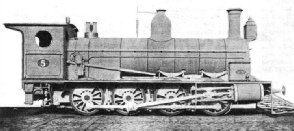
EIGHT-COUPLED GOODS ENGINE in service on the Mauritius Government Railways. The island has 111 miles of standard-gauge track open, served by some fifty locomotives, 187 carriages, 747 wagons and four rail-motor trolleys. There are also 14½ miles of 2 ft 6 in gauge track open, with three locomotives, one carriage and 162 wagons.
Going farther east we find things rather different in Mauritius. Here is a little island with an area of 720 square miles, and served by an efficient railway system, with 111 miles of line built to the standard gauge, together with fourteen miles of 2 ft 6 in gauge line. For all its small size and remarkable beauty, Mauritius is a highly industrial island, with great exports of sugar and its by-products, and of vanilla. The narrow-gauge section of the railway alone has six miles of sidings for dealing with the sugar-cane traffic. There are fifty-seven locomotives, and the total rolling-stock is in advance of that of Madagascar. The Mauritius Railways are among the oldest established in any British Crown Colony. The locomotives are typical examples of British colonial practice. As far back as in 1867 the Mauritius Railways introduced the eight-coupled type, in the form of a powerful saddle-tank engine built by Sharp, Stewart and Co. This was one of the first eight-coupled locomotives to be built in Great Britain, and was the forerunner of the famous 0-8-0 tank engines built some ten years later for the Ghât inclines of the Great Indian Peninsula Railway. It is strange to find this complete, self-contained railway, running on the standard gauge, with a length of over one hundred miles, on a small island five hundred miles out in the Indian Ocean. The whole island is old and interesting, with its four distinct languages, French, English, Hindustani, and Chinese.
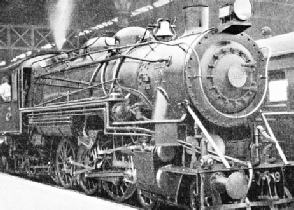
AN OIL-BURNER AT MANILA STATION. In 1890, the first railway on Luzon Island in the Philippines was completed. Originally built and owned by a British company, it is now under American control. Lines radiate from the capital of Manila, and there are some luxury expresses. The Manila Railroad possesses about 160 locomotives and 2,500 coaches.
Still farther east, in the East Indies, is the railway system of the Philippine Islands. The principal island, Luzon, is served by the Manila Railroad, opened in 1890. This was originally owned by a British company, but it became American after the USA had acquired the Philippine Islands in 1898, in consequence of the war with Spain. The gauge is 3 ft 6 in, and the mileage 726. There are about 160 locomotives and 2,500 coaching vehicles, as well as numerous rail-cars. The Philippine Railway, operating in the islands of Panay and Cebu, is also on the 3 ft 6 in gauge. Over 130 miles are open and about 370 miles are authorized.
Borneo and Sumatra are a long way behind Java in the matter of railway development. The Sumatran railways, however, are not dissimilar to the Javanese in general aspect and equipment, though not in extent. The two principal administrations are the Sumatra State Railways - part of the Netherlands East India State Railways - with 829 miles of line, and the Deli Railway Company, with 335½ miles, all the lines being built to a gauge of 3 ft 6 in. The best rolling-stock of the Deli Railway may be taken as typical. It includes fine 2-6-4 tank engines built at Amsterdam, and well-appointed corridor coaches, rather after the Pullman style, with sunshades and clerestory roofs.
Borneo’s System
If, on the West Indian railways, the traveller may occasionally meet with mild entertainment on the part of iguanas, in the East Indies the wild beasts of the forest are of a rather more formidable nature. Tigers are more plentiful than pleasant, and fear the railway rather less than they fear the crocodiles. Elephants, too, while they are wise and tactful animals, as a rule, will sometimes take it into their heads to browse on the trees overhanging the track, and once or twice an old rogue elephant has been known to charge and overturn a locomotive, with fatal results to himself.
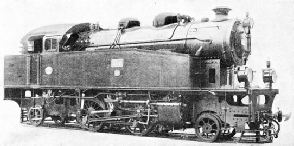
IN SUMATRA. A 2-4-2 tank locomotive in operation on the Deli Railway of Sumatra, Netherlands East Indies. This railway has 335½ miles of line open, of 3 ft 6-in gauge, and owns about 63 locomotives, 227 carriages, 1,696 wagons and one steam rail-car.
Finally, in British North Borneo, there is the only railway in the island, the 125-miles system of the North Borneo Government Railways.
The line, which is built to the metre gauge, is laid through picturesque but difficult country and crosses long stretches of jungle, hill ranges and the many streams which thread the country. The first section of the railway, the twenty miles from Beaufort to Weston, was completed in 1900, and two years later the line had been extended another fifty-seven miles to Jesselton on the South China Sea. The third portion of the line, linking Beaufort with Tenom, took seven years to build—a strenuous task in the face of landslides, floods, and wash-outs. This section of the line traverses the wonderful scenery of the Padras River gorge.
The line was reconstructed in 1912, wooden bridges were replaced by steel structures, curves were straightened as far as possible, and the track was relaid with a heavier rail than that of the original railway. Locomotive workshops were built at Tanjong Aru. There are thirteen locomotives in use, including 4-6-0 tender engines with some 4-6-4, 0-6-4 and 0-4-2 tanks, burning wood fuel.
The rolling-stock comprises first, second, and third class coaches and many different types of wagon, including covered vans, low-sided trucks, cattle and timber trucks and brake vans.
The first-class passenger cars, in spite of the short distance they have to cover, are comfortably fitted up with cane sofas, revolving chairs, and deep sunshades over the windows. A luxury coach, designed and built in the local railway workshops, is reserved for the Governor and distinguished visitors.
One other island railway deserves mention. It is only about half a mile in length, and is not even working now. But it is in Spitsbergen, and it connects the closed-down collieries at Ny-Aalesund with the jetty at King’s Bay. As such, it stakes an undisputed claim to be the world's most northerly railway line.
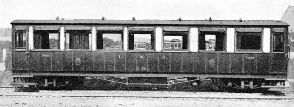 A THIRD-CLASS SALOON on the Isle of Man Railway. This system has over forty miles of 3 ft gauge track open, and the company operates sixteen locomotives, 115 carriages and 175 wagons. The coaches are mostly electrically lit but not steam-heated, tin foot-warmers being used.
A THIRD-CLASS SALOON on the Isle of Man Railway. This system has over forty miles of 3 ft gauge track open, and the company operates sixteen locomotives, 115 carriages and 175 wagons. The coaches are mostly electrically lit but not steam-heated, tin foot-warmers being used.
You can read more on
“Ireland’s Railway Systems”
and
“Rail Transport in Ceylon”
and
“The Railways of Fiji”
on this website.





 A STANDARD 2-
A STANDARD 2-



 A THIRD-
A THIRD-